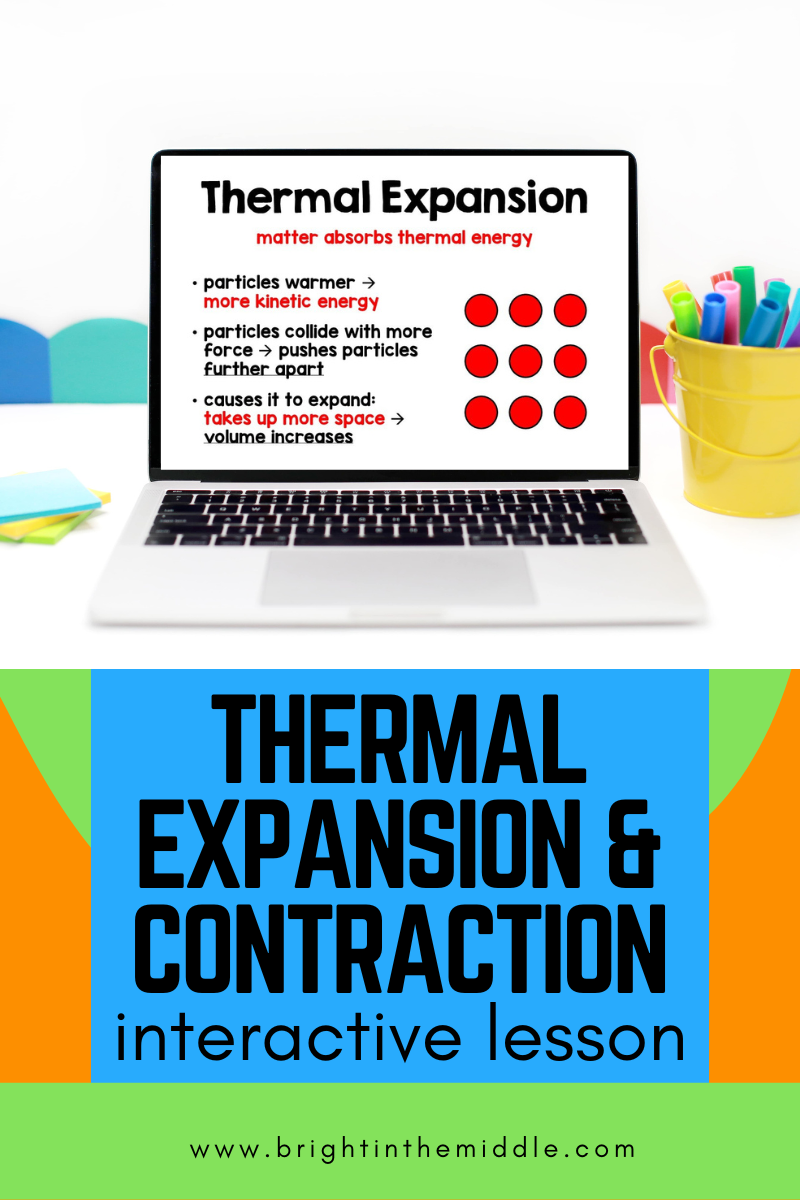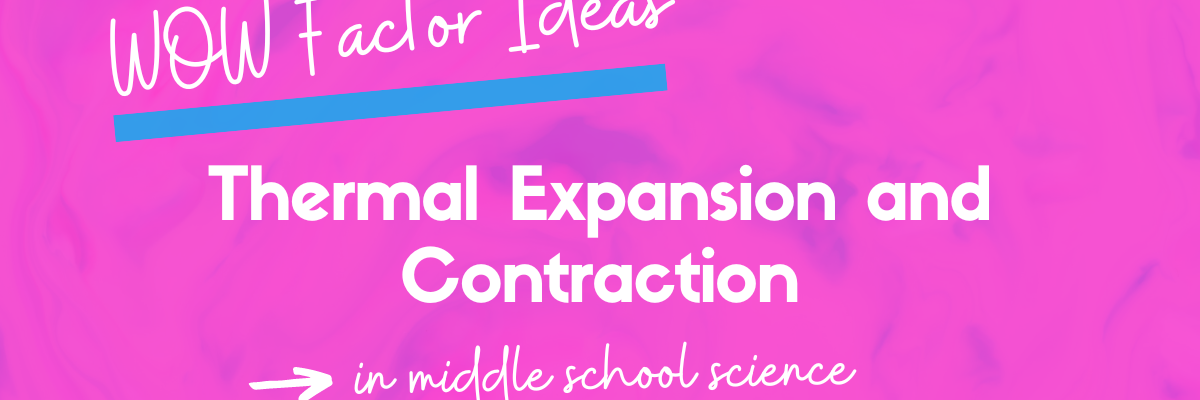Are you in your thermal energy unit? Are you teaching about thermal contraction and expansion? Boy, do I have some ideas for you to bring the WOW Factor to your classroom!
What is thermal expansion and thermal contraction? Thermal expansion occurs when matter absorbs thermal energy. When the particles become warmer, there is more kinetic energy. The particles collide with more force, pushing the particles further apart. This causes it to expand.
Thermal contraction occurs when matter loses thermal energy. The particles become cooler, and there is less kinetic energy. The particles get closer together, causing it to contract.
In this post, I share different ways to hype your students up for this lesson and help them become internally motivated to learn. I call these WONDER strategies. Then, I share an interactive lesson that is great to use to teach this content because it helps students to OVERCOME OVERWHELM and not take in too much information at a time. Finally, I share some WIDEN strategies that will help extend student knowledge about thermal expansion and contraction.

Expansion and Contraction WONDER Activities
It’s important to get your students hooked into a lesson! You want to help them become internally motivated to learn! Once you do, teaching is a piece of cake because they are curious to learn more. Here are three ways to help your students WONDER more about thermal contraction and expansion.
Thermal Contraction and Expansion Post-It Activity
I love post-its! They are one of my favorite things to use in the classroom. They make for a great discussion tool.
So, in this activity:
- Give each of your students one post-it note.
- Then, ask them this question, “Why would warming a metal jar lid make it easier to open?”. (They may or may not realize that running a stubborn metal jar under some warm water could make it slightly easier to open. This is because when the lid is warmed, it expands.)
- Let students make their guesses and write them down on a post-it note.
- Once they have their answer, students can come place them on a designated spot on the board.
- Either you or a student volunteer can then read off some of the answers. Are there any patterns?
This is a great way to get students thinking and start wonderful conversations!

Thermal Expansion of Liquid Demo
This is a fun demo where students can see thermal expansion taking place!
You will need:
- a clear bottle or graduated cylinder
- water
- a container of hot water
- something to mark with (like a permanent marker)
- You will need to fill a clear bottle or graduated cylinder with water. It will be better to have a container that is thin or has a neck so you will more easily see the expansion.
- Mark the water level.
- Have students make a prediction of what will happen to the water if placed in a container of hot water.
- Place the bottle into the container of hot water. Wait for 5 to 10 minutes.
- Observe what happens to the water level.
Bring in Some Theming!
I love a good theme! I think you can bring in some theme to every lesson, and this one is no exception. Along with some of the other WONDER strategies, you can get students excited by just having some related things to go along with the lesson of thermal contraction and expansion.
Theming is a great idea to include in some of the “more boring” lessons in your classroom. Which, I’m biased, there aren’t many because science is awesome!
- Thermal Energy Themed Songs
While students are completing their activities related to this topic, you can play some songs in the background related to thermal energy gain and losses! For example, you could play Ice Ice Baby by Vanilla Ice or Heatwave by Martha Reeves and The Vandellas!
- Wear Thermal Energy Colors
Tell students in advance to wear colors that represent thermal energy! You can let them decide what that means! However, most people think of the colors like red and orange when thinking of heat.
- Eat Chocolate!
If you have been following for any amount of time, you know that I’m a fan of food in the classroom! Why chocolate? Well, chocolate heats and expands like a lot of other matter. When it melts, it expands slightly, and when it is cooled, it contracts and solidifies. This is a delicious discussion starter!
Thermal Expansion and Contraction Interactive Lesson
At this point, your students should be hype to learn more about this topic! Now is the time to dive into more complicated concepts and vocabulary.
I love interactive lessons! They are designed to deliver content to students in a way that reduces their cognitive load, ultimately helping them remember the information. If they learn too much at a time, they end up not learning anything at all!
Interactive lessons are great for a lesson, of course, but they also make great homework, review, and more!

What is thermal contraction and expansion? What is the difference between thermal expansion and thermal contraction? In this Thermal Contraction and Expansion Interactive Lesson, students learn all about this and more! They learn about thermal energy, temperature, how the size of the particles does not change when heat is added or lost (distance does), real-world applications, and more.
Inside, there are embedded questions to help students process and understand the information they are taking in. These include drag-and-drop activities, a KWL, chart, exploring outside resources, and more!
You can find this in the Bright in the Middle Shop.
You can also find this on TPT.
Thermal Expansion and Contraction WIDEN Activities
Have time to teach some more? I got you! These activities will help students explore, expand, and WIDEN their knowledge on thermal contraction and expansion. Here are three activities to try out!
Thermal Energy and Particle Motion Investigations
Who doesn’t love stations? In these stations, students will explore about how the thermal energy in a substance impacts the particle motion, where expansion and contraction take place.
You can set up four stations, and these are super easy! You will only need materials like water, food coloring, balloons, bowls, and other things that are easy to access.
Although these are easy to set up, this does not mean that they are not powerful in helping students understand what happens with thermal energy transfers in matter! They are great thermal expansion and contraction examples.
You can check out more information about these stations in the Bright in the Middle Shop and on TPT.
STEM Challenge – Design a Bridge
Another fun thing to do is a STEM Challenge! You can give students materials like straws, tape, rubber bands, glue, popsicle sticks, cardboard, and things of that sort and have students create a bridge! However, they have to take thermal expansion and contraction into consideration!
You can give them other constraints such as a minimum weight and maximum length to add more challenges.
To test them, you can use hair dyers or heat lamps and then cool them with fans. Did they pass the test of thermal contraction and expansion?
Artistic Expression
Some students are so creative and love art, so it’s ok to bring on the paint sometimes! You can even collaborate with the art teacher in the school if you are lucky enough to have one.
What is thermal expansion? What is thermal contraction? Let students explain through art! So, what you can do is collect some paint and brushes, markers, colored pencils, paper, etc., and have students to express their understanding of this topic using art! Your students will have to actively engage in the material to be able to model these concepts through art!
Which activities will you choose for thermal contraction and expansion?
Bright in the Middle is a participant in the Amazon Services LLC Associates Program, an affiliate advertising program. As an Amazon Associate, I earn from qualifying purchases.
Help your students master science content!



[…] Thermal Expansion and Contraction […]